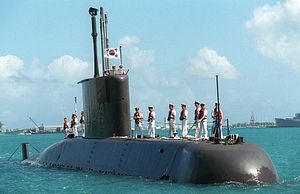In February 2015, South Korea launched an independent submarine command — only the sixth of its kind in the world — bringing operations, logistics, training, and maintenance under one roof, according to Republic of Korea (ROK) naval officials.
“The command’s main mission is to better protect the country from North Korean naval provocations, as the North is increasingly building up its underwater capabilities,” Cmdr. Lim Myung-soo, at the ROK Navy’s public affairs office, stated.
Ever since the 1990s, the backbone of the ROK’s submarine fleet has been a fleet of nine 1,200-ton Chang Bogo-class diesel-electric attack submarines – a variant of the German Type 209 Howaldtswerke-Deutsche Werft SS vessel. South Korea plans to upgrade all nine subs with air-independent propulsion and flank-array sonars over the next few years.
The ROK Navy is also in the process of acquiring nine German Type 214 — designated Son Won-II-class — diesel-electric attack submarines built under license by Hyundai Heavy Industries and Daewoo Shipbuilding & Marine Engineering in South Korea.
The four 1,800-ton ships already in service with the ROK Navy are equipped with air independent propulsion systems and, according to some reports, will also be upgraded with vertical-launch systems (VLS) for missiles. The ambitious plan is to commission five more Son Won-II-class subs by 2019,* with an option of adding three more at a later stage.
In addition, the ROK Navy also fields 11 midget submarines primarily used for training purposes.
The most ambitious project so far is South Korea’s first indigenously produced modern 3,000-ton diesel-electric attack submarine – designated KSS-III – equipped with, “multiple vertical launch tubes to fire 1,500-kilometer cruise missiles that could hit key targets in North Korea,” according to Defense News.
The first of nine boats is scheduled to enter service in 2022 at a cost of around $ 800 million per unit. According to media reports, the last KSS-III is expected to be delivered in 2029. Furthermore, the navy is planning to procure 12 more helicopters for anti-submarine operations, in addition to 12 frigates with anti-submarine warfare capabilities scheduled to enter service by 2020.
However, Defense News reports that corruption might undermine South Korea’s naval modernization program. For example the navy’s former Chief of Naval Operations (CNO), Adm. Hwang Ki-chul, has been indicted for manipulating documents during the evaluation process of a ship’s performance so that a foreign supplier, favored by Hwang, could win the bidding contract.
In addition, the former head of the navy, CNO Chung Ok-geun, has also been arrested on charges of taking bribes. Defense News quotes Yang Wook, a researching member of the Korea Defense andSecurity Forum (KODEF): “A series of arms procurement corruption scandals has eroded public confidence seriously in the Navy’s arms buildup efforts. That means any naval buildup programs in the future will be censored thoroughly and questioned every time, which could delay the timing of weapons deployment and harm the security posture.”
As tensions with North Korea — which is believed to have a fleet of 70 submarines — continue, Seoul will have to quickly address such discrepancies within its naval forces or risk an erosion of public confidence in the ROK Navy.
*A previous version of the piece misidentified the year as 2015.

































